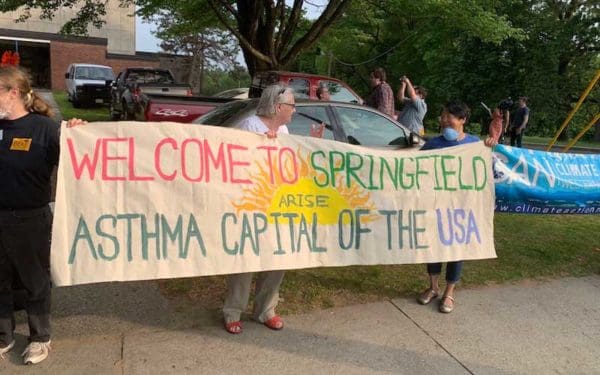
Toxic chemicals are putting Maine's drinking water – and health – at risk, but federal and state regulators are failing to keep up with the dangers. Photo: Vizaphoto Photographer via Shutterstock
In communities from Houlton, Maine, to Flint, Michigan, the safety of our drinking water can no longer be taken for granted.
The newest threat comes from a suite of human-made chemicals collectively known as PFAS – per- and polyfuoroalkyl substances. These dangerous chemicals do not break down over time; they remain in the environment – and our bloodstreams – for decades, and they are toxic to our health. And they have been detected in Maine waters from Kittery in York County to Limestone in Aroostook County.
Since the mid-20th century, PFAS have been used widely in products that many of us rely on every day – nonstick cookware, food wrappers, water-repellent clothing, stain-resistant fabrics and carpets, some cosmetics, some firefighting foams, and products that resist grease, water, and oil. Today, there are approximately 3,000 or more different kinds of PFAS.
Scientific studies show that PFAS may adversely affect growth, learning, and behavior in infants and children, as well as make it more difficult for a woman to get pregnant. PFAS may interfere with natural human hormones and the immune system, increase cholesterol, and disrupt liver, thyroid, and pancreatic function. Researchers also suspect that some PFAS may increase the risk of cancer. They stay in our blood for years, and no medical interventions will remove them from the body.
Production of at least two kinds of PFAS – perfluorooctanoic acid, or PFOA, and perfluorooctanesulfonic acid, PFOS – has been phased out due to the dangers they pose to human health and the environment. But these chemicals will remain in drinking water sources for decades to come. In the meantime, manufacturers are replacing them with new PFAS that may cause similar adverse health effects – and federal and state regulators simply can’t keep up.
Federal Regulators are Failing to Protect Us
Due to weak federal chemical safety laws, PFAS have largely escaped regulation. That means that manufacturers historically have not had to monitor, let alone report, releases of PFAS into the air, water, or on land.
The Environmental Protection Agency (EPA) and PFAS manufacturers have known about the risks these dangerous chemicals pose for more than a decade, but they have failed to take meaningful action to protect the public. Instead, EPA has allowed manufacturers to continue using them. There is still no federal standard for what is considered a safe amount of PFAS in drinking water.
In effect, PFAS have been “invisible” to regulation – at least until the discovery of widespread contamination of drinking water supplies in New England and across the country.
PFAS Are in Maine Waters
PFAS are in waters throughout New England. In Maine, they’ve been detected in drinking water, groundwater, and surface waters throughout the state, primarily at and around former military bases that used firefighting foams. Testing at the former Loring and Brunswick bases as well as the Portsmouth Naval Shipyard in Kittery and the Sanford Seacoast Regional Airport all show PFAS levels that exceed EPA health Advisory Limits – which, as we’ve already noted, are not stringent enough to meaningfully protect public health.
Similar contamination has been found in other New England states, including Vermont, New Hampshire, and Massachusetts.
States Must Lead in the Absence of Federal Safeguards
In the absence of federal action, states must act to protect us from this toxic threat to our health and environment. In recent years, some state regulators have taken steps to address PFAS in drinking water. For example, Vermont has set one of the country’s most stringent health advisories and groundwater cleanup standards for some PFAS, proactively testing drinking and groundwater throughout the state, and forming an Interagency Committee on Chemical Management to help identify how to prevent another drinking water crisis from a previously unknown toxic chemical.
And New Hampshire has just announced new regulations to address the risk, but they only target three of the more than 3,000 known PFAS compounds. Maine, on the other hand, has yet to regulate PFAS at all. Instead, it has issued policy guidance based on EPA’s insufficient advisory limits, and to date has performed only limited water sampling for just a small number of PFAS compounds.
But without a drinking water rule that requires public water systems to monitor and treat unsafe levels of all PFAS compounds, these actions are not enough to protect New Englanders.
States can – and must – do more.
That’s why CLF filed a petition – jointly with Toxics Action Center – with the Maine Department of Health and Human Services to demand that state regulators adopt a drinking water treatment standard for all PFAS compounds and require public water systems to conduct regular monitoring and treatment of unsafe levels of PFAS. Similar petitions were filed in other New England states as well.
Learn More and Get Involved
Protecting our drinking water from this public health threat will take all of us understanding the facts and being willing to call on our state officials to act. Please, share this blog to spread the word about this threat lurking in our waters. Then, be sure you’re signed up for our email alerts so you’ll be the first to know when you can speak up to help move this critical work forward.
Together, we can ensure that our drinking water is safe here in Maine and across New England.
[widget id=”clf_cta_widget-3″]



